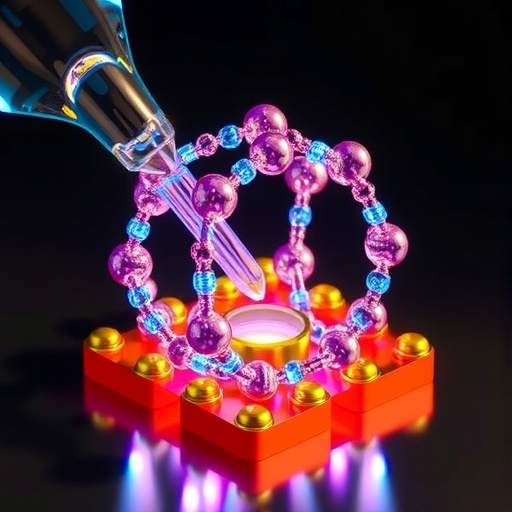In a groundbreaking study poised to redefine the landscape of sustainable energy production, researchers have made significant advancements in the field of electrocatalytic water splitting. The recent work led by Chen, J., Zhang, H., and Shi, Z., has unveiled an innovative approach through bimetallic doping in cobalt-based metal-organic frameworks (Co-MOFs). This method dramatically enhances the efficiency of water splitting, a crucial process for hydrogen production and ultimately, renewable energy applications.
Water splitting is an electrochemical reaction that separates water into its constituent elements: hydrogen and oxygen. Hydrogen, heralded as a clean fuel of the future, can be harnessed in fuel cells to generate electricity or used in various industrial processes. However, achieving high efficiency in water splitting has proven to be a persistent challenge in electrochemical technology. Traditional catalysts often face limitations in activity and stability, leading researchers to explore new materials that can overcome these barriers.
Through their innovative research, the team incorporated bimetallic doping into Co-MOFs, effectively creating a two-metal system that significantly enhances the overall catalytic performance. This strategy allows for the synergistic effects of different metals to be harnessed, optimizing catalytic routes and increasing the material’s intrinsic activity. The findings demonstrate that the tailored bimetallic composition results in dramatic improvements in electrocatalytic efficiency compared to conventional single-metal systems.
.adsslot_y4ftHkD8CU{width:728px !important;height:90px !important;}
@media(max-width:1199px){ .adsslot_y4ftHkD8CU{width:468px !important;height:60px !important;}
}
@media(max-width:767px){ .adsslot_y4ftHkD8CU{width:320px !important;height:50px !important;}
}
ADVERTISEMENT
In practical terms, the bimetallic doping process involves adjusting the ratios of cobalt and additional metals, which leads to modifications in electronic properties and surface characteristics. These changes facilitate a more favorable interaction with electrolyte solutions, boosting charge transfer processes. The optimization of these parameters is crucial for maximizing hydrogen production rates.
Furthermore, the insights gained from this study extend the understanding of metal-organic frameworks themselves, which have emerged as versatile candidates for various catalytic and adsorption applications. Their tunable structures and vast surface areas make them invaluable in future material science developments. By dissecting the electrocatalytic properties of bimetallic Co-MOFs, researchers are likely to inspire new avenues for exploration within the domain of advanced materials.
The results of this study have already sparked interest across multiple scientific disciplines, from material science to chemistry and environmental engineering. The newfound ability to tweak catalytic properties at the nanoscale represents a significant leap forward in synthesizing materials tailored specifically for energy applications. Each subsequent discovery arising from this research may contribute to the establishment of sustainable technologies that align with global energy goals.
The prospect of widespread adoption of these technologies hinges on further scaling up production methods and ensuring economic feasibility. Although the current findings are promising, researchers recognize the importance of bridging the gap between laboratory results and real-world application. This includes exploring potential commercialization pathways and assessing the environmental impact of upscaling production processes.
In conclusion, the innovative research conducted by Chen, J., Zhang, H., and Shi, Z. marks a significant milestone in the quest for efficient and sustainable water splitting technologies. By leveraging the power of bimetallic doping within Co-MOFs, this team has not only enriched our understanding of electrocatalytic processes but has also laid down a challenging invitation to the broader scientific community. As we stand on the brink of a new era in hydrogen production, the implications of this research could lead to transformative advancements in clean energy technologies worldwide.
This work is emblematic of how interdisciplinary research can tackle complex issues like climate change and energy sustainability through collaborative scientific inquiry. The future will tell how rapidly these findings can transition from the laboratory to industries, influencing the strategies we employ to combat the pressing challenges of our time. With the ongoing support for such innovations, we may soon see a more sustainable energy paradigm emerge as a reality.
Subject of Research: Electrocatalytic water splitting performance via bimetallic doping in Co-MOF
Article Title: Enhanced electrocatalytic water splitting performance via bimetallic doping in Co-MOF.
Article References: Chen, J., Zhang, H., Shi, Z. et al. Enhanced electrocatalytic water splitting performance via bimetallic doping in Co-MOF. Ionics (2025). https://doi.org/10.1007/s11581-025-06563-z
Image Credits: AI Generated
DOI: https://doi.org/10.1007/s11581-025-06563-z
Keywords: Electrocatalysis, Water Splitting, Bimetallic Doping, Co-MOF, Hydrogen Production, Renewable Energy, Sustainable Technologies, Metal-Organic Frameworks
Tags: advancements in sustainable energy researchbimetallic doping in Co-MOFschallenges in water splitting technologyclean fuel production through electrochemistrycobalt-based metal-organic frameworkselectrocatalytic water splitting efficiencyenhancing catalytic performance in water splittinginnovative catalysts for electrochemical reactionsoptimizing intrinsic activity of catalystsrenewable energy applicationssustainable hydrogen production methodssynergistic effects of bimetals in catalysis





